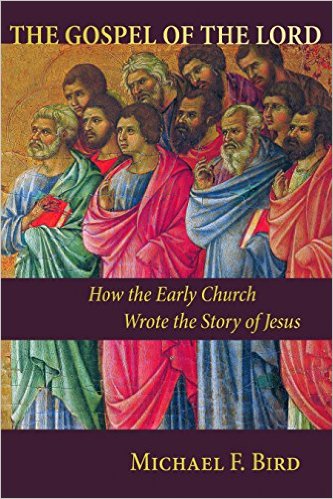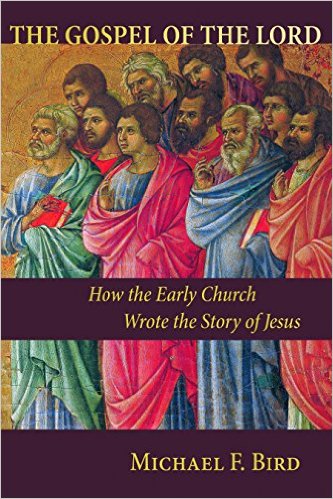The Gospel of the Lord: How the Early Church Wrote the Story of Jesus

A Denver Seminary Book Review by Denver Seminary Professor of New Testament William W. Klein

Michael F. Bird. The Gospel of the Lord: How the Early Church Wrote the Story of Jesus. Grand Rapids; Cambridge, UK: Eerdmans, 2014. 408 pp. Paperback. $30.00 / £19.99. ISBN 978-0-8028-6776-6
While there is no shortage of books devoted to the Gospels, this one fills a niche that is sorely needed What is more, it is clearly and concisely written, up-to-date in discussing developments, critical in the best sense, thoroughly-documented, while raising and answering the important questions that matter to most readers of the four Gospels. The author is Lecturer in Theology at Ridley College in Melbourne, Australia and Visiting Research Professor at Houston Baptist University. He is also an Anglican Priest. Prof. Bird has written numerous other books, including several on Jesus and the Gospels. This volume concentrates on the origins of the Gospels, seeking to answer foundational questions: how did we arrive at (only) four canonical gospels, why were they written, how did the writers get their information, what is the nature of the writings they produced, and how do these stories function in the earliest spread of the message about Jesus, the one called Christ? While several of the chapters of the book appeared in various earlier forms, these have been significantly revised to make them current. The result is a very pleasing and coherent presentation that makes a significant case for the trustworthiness of the gospel accounts.
This book will be particularly useful to evangelical students, for the author addresses and clearly responds to views that debunk or devalue the historical veracity of the gospels’ renditions of the life and ministry of Jesus. The book also provides an excellent foundation upon which to build one’s further study of the Gospels. Bird tackles the issue of the purpose the evangelists had in preserving Jesus’ words and the contours of his ministry (and addressing the issue of whether the earliest Jesus followers were able to preserve them accurately). He pursues the question of why the early Christians were committed to this enterprise. He addresses the mechanism for the preservation of the Jesus tradition–how those traditions were passed–including a consideration of orality and memory that Prof. James Dunn also gave considerable attention to (in Jesus Remembered, Eerdmans, 2003; cf. Richard Bauckham, Jesus and the Eyewitnesses, Eerdmans, 2006). Since the evangelists were not (all) eyewitnesses to Jesus’ ministry, Bird considers how they come upon the traditions, and what they did with their sources–including the questions of genre and why they chose the way of writing the story as they did–arguing convincingly along several avenues of evidence that they preserved the traditions accurately.
One extremely useful feature of the book is Bird’s inclusion of excurses at the conclusion of each of the six chapters. Their titles demonstrate the variety of purposes they serve for the writer (and readers): “From Oral Gospel to Written Gospel”; “An Evangelical and Critical Approach to the Gospels”; “The Failure of Form Criticism”; Patristic Quotations on the Order of the Gospels”; “What About the ‘Other’ Gospels?”; and “The Text of the Gospels in the Second Century.” In addition to addressing these pertinent issues, the excurses serve another very valuable function–putting primary materials before the reader to let the evidence speak for itself (along with Bird’s judicious guidance along the way).
In reply to the charge that the early Christians were disinterested in the historical Jesus but rather interested in (and constructed their) “Christ of faith” in the Gospels, Bird concludes: “… interest in the historical back-then-ness of the person of Jesus was not obliterated by faith in him as the crucified and risen Lord and not worn away by charismatic enthusiasm for the voice of the risen Lord, but inherent within the very praxis of the early Christian movement and epitomized in the Gospels” (p. 38). Being largely convinced by Kenneth Bailey’s theories about community preservations of oral traditions, Bird states: “The theory of an ‘formally controlled’ oral tradition looks like a plausible and realistic model for how the Jesus tradition might have been transmitted” (95). His consideration of the various facets of how traditions are preserved in a community leads Bird to boldly assert, “… the goal of source criticism and tradition criticism needs to be radically overhauled. It can no longer be defined in terms of separating history from theology or identifying layers of tradition, but should be conceived as tracing the impact of a memory in the formation of early Christianity” (105).
Bird’s consideration of the synoptic problem is clear and well-illustrated with charts of various pericopes, showing both Greek and English texts for comparison. Not only does he discuss the standard theories to account for the features in the synoptics (Augustinian, Griesbach, Hebrew/Aramaic Ur-Gospel, Common Oral Traditions, the Two- [Four-] Source, and the Farrar theories), but he presents his own (though not unique to him) view that deserves a wider hearing. In brief that theory adopts the most popular two- (four-) source theory but adds an additional step: Luke also used Matthew–in addition to using Mark, Q, and L.
As to the authorship of the fourth Gospel, Bird says, “The most compelling conclusion is that the Fourth Gospel is indebted to the testimony of a Judean disciple of Jesus who later led a Christian community in Ephesus” (191). On the relationship between the synoptics and John, Bird eschews simple either/or solutions. Here a quote says it best: “I suggest that we envisage the spasmodic interpenetration of Synoptic and Johannine tradition across each other in pre-literary stages, recognize the independent nature of many of John’s sources, and imagine also John’s exposure to the Synoptic tradition through either a prior reading or from observing an oral performance of a Synoptic text, probably Mark and perhaps also Luke” (212).
After considering the various options, Dr. Bird argues that the Gospels can best be characterized as what he calls biographical kerygma, that is, the “textual imprint of the oral phenomena of Christian preaching and teaching about Jesus” (270). While they closely parallel Greco-Roman biographies in form (βιοι or vitae), the Gospels point in a distinctive and fundamentally salvation-historical direction. Their purpose is to maintain access to the apostolic eyewitness testimony to Jesus, and are designed to be read aloud in the churches to create a Christ-shaped community so that readers can place themselves in the story of Jesus.
Much more could be said about this important book. As I noted, everyone who wants a clear and well-reasoned approach to the origin and nature of the Gospels should read this book. It’s the best primer now available, but it’s not simple or simplistic in its scope or the level of its treatment of the issues. Bird is eminently fair in considering all the options, but unlike some authors who discuss options and leave the reader in a maze, Bird identifies and defends the options he believes are most compelling. And if none measure up as he would like, Bird is not averse to tweaking views in ways that he believes better account for the data and answer the important questions.
William W. Klein, PhD
Professor of New Testament
Denver Seminary
July 2016
